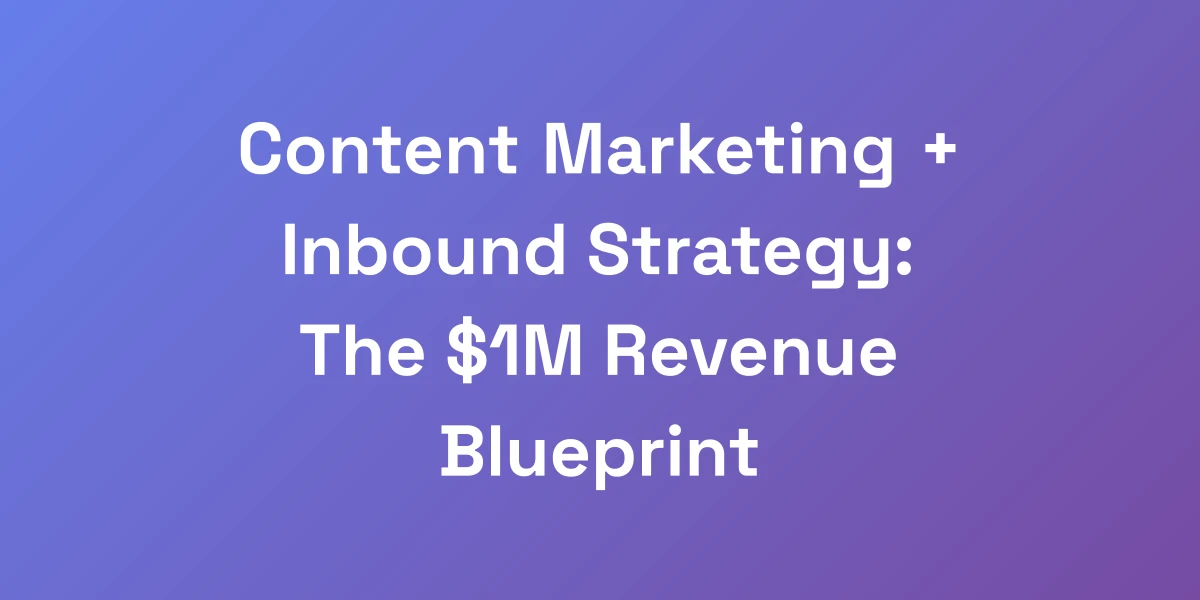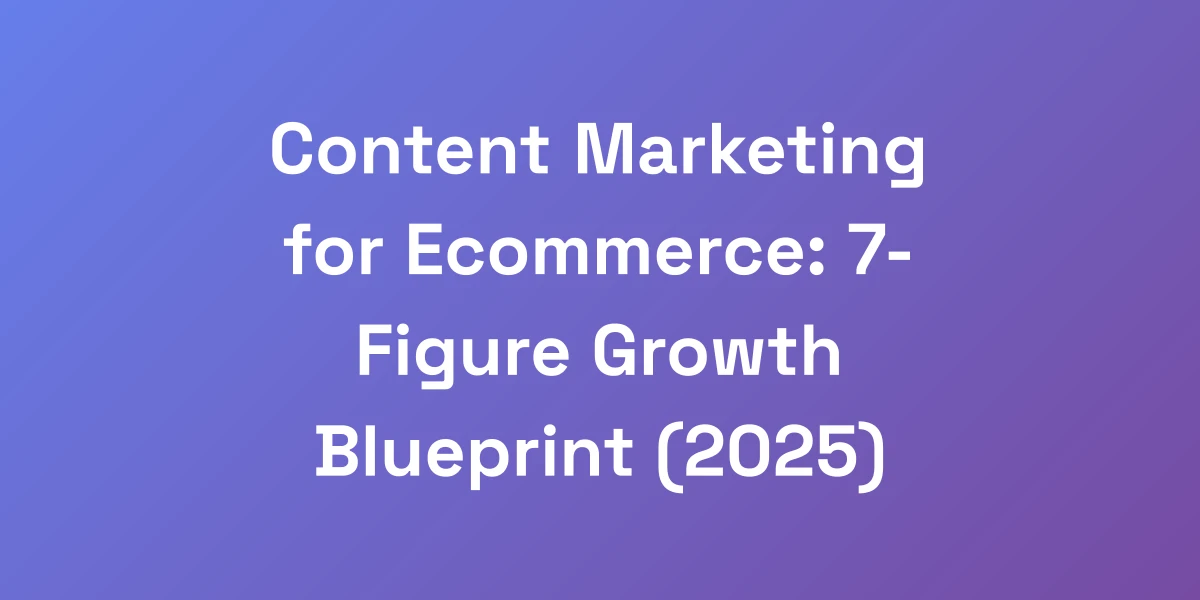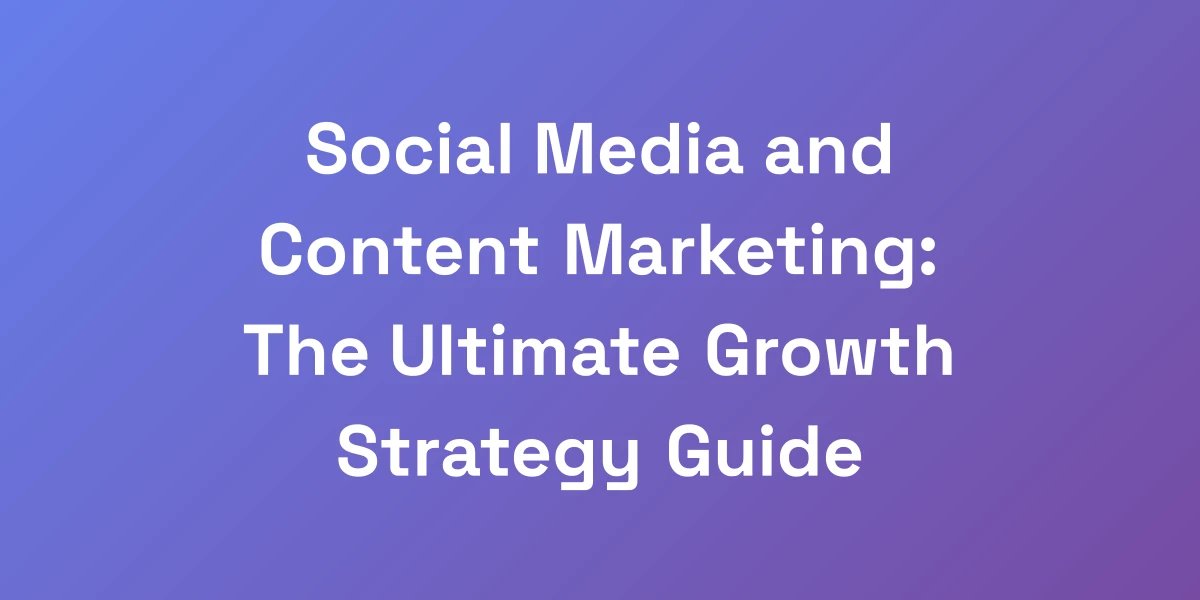
7-Figure Ecommerce Content Strategy: The Ultimate Revenue Growth Blueprint
Mar 6, 2025 | By [email protected]
The $100M Mindset: Why Most Ecommerce Content Strategies Fail
Let us hit you with some truth: 90% of ecommerce businesses are leaving millions on the table because they’re playing checkers while the top 1% are playing chess. Your content isn’t just about pushing products—it’s about building an empire.
We’ve helped countless businesses scale from 6 to 7 figures, and the difference always comes down to one thing: treating your content strategy like a profit-generating machine, not a creative writing exercise. Here’s what the market leaders know that you don’t.
The Cost of Playing Small with Your Content
When you approach content as a secondary tactic, you’re undermining your entire revenue potential. Playing small means missing out on vast opportunities to engage and convert customers at every stage of their journey.
Consider this: businesses that treat content as a core component see a 58% increase in sales and revenue due to their strategic efforts. Not leveraging your content fully is like leaving money on the table.
- Limited Reach: Small-scale content strategies fail to capture a broad audience.
- Weak Engagement: Inadequate content fails to build a loyal customer base.
- Lower Conversions: Without a robust strategy, turning visitors into buyers becomes a challenge.
Are you ready to stop playing small and start maximizing your content’s potential? Consider implementing a data-driven content marketing strategy for small businesses.
Why Traditional Content Marketing Advice Is Killing Your Sales
Traditional content marketing advice often focuses on generic strategies that no longer work in today’s competitive landscape. It’s outdated and misses the mark on what truly drives sales.
Why stick to the old playbook? The ecommerce landscape has evolved, and so should your strategies. Relying on outdated methods means you’re not optimizing for today’s consumer behaviors and expectations.
- One-Size-Fits-All: Traditional advice doesn’t account for unique business needs.
- Lack of Personalization: Modern consumers crave personalized experiences.
- Ignoring Data: Data-driven strategies outperform generic ones every time.
Are you still following advice that doesn’t move the needle for your sales?
The Value-First Content Framework
Shifting to a value-first approach transforms your content into a powerful revenue driver. It’s about delivering undeniable value that attracts, engages, and converts your audience.
Here’s how to implement a value-first framework:
- Understand Your Audience: Deep dive into what your customers need and want.
- Deliver Consistent Value: Provide content that educates, entertains, and inspires.
- Build Trust: Create reliable and trustworthy content that positions you as an authority.
Have you considered how a value-first approach can elevate your ecommerce strategy?
Setting Up Your Content Profit Centers
Your content should be diversified into specific profit centers, each contributing to your overall revenue. This ensures your content strategy is always aligned with your financial goals.
Here are key profit centers to establish:
- SEO-Driven Content: Capture organic traffic with optimized content.
- Paid Content: Invest in content that supports your advertising efforts.
- Email Marketing: Nurture leads and drive repeat purchases through targeted emails.
Have you identified your primary content profit centers yet? Consider leveraging insights from the SEO Freelancer’s Blueprint to enhance your content profit centers.
Metrics That Actually Matter for Revenue
Focusing on the right metrics can make or break your content strategy. It’s not just about vanity metrics but understanding what drives revenue.
Key metrics to track include:
- Conversion Rate: Measure how well your content turns visitors into customers.
- Customer Lifetime Value (CLV): Understand the long-term value each customer brings.
- Return on Investment (ROI): Evaluate the profitability of your content initiatives.
Implementing SEO Automation tools can significantly improve your ROI by streamlining optimization processes.
Are you tracking the metrics that truly impact your bottom line?
Engineering Your Content Ecosystem for Maximum ROI
Stop creating content for the sake of content. Every piece you publish should be a calculated move in your larger revenue strategy.
Think of your content as a sales team that works 24/7, consistently bringing in qualified leads and closing deals while you sleep. We’re going to show you how to build a self-sustaining content machine that turns casual browsers into repeat buyers and brand evangelists.
The Product-Content Matrix
Developing a Product-Content Matrix is essential for aligning your products with the right content types. This matrix ensures that each product is supported by content that highlights its unique value propositions.
- Top of the Funnel: Educational content that introduces your products.
- Middle of the Funnel: Comparative and detailed content that nurtures leads.
- Bottom of the Funnel: Conversion-focused content that drives purchases.
Have you mapped out how each of your products is supported by specific content types?
Creating Your Content Value Ladder
A Content Value Ladder structures your content based on the value and depth, guiding customers from initial awareness to making a purchase.
- Aware: Blog posts and social media updates to capture attention.
- Engage: Webinars and detailed guides to build interest.
- Convert: Case studies and product demos to drive decisions.
Is your content ladder leading customers seamlessly through their buying journey?
Automated Content Distribution Systems
Automation is the backbone of a scalable content strategy. Implementing automated systems ensures consistent delivery and maximizes your content’s reach. Consider using strategies from the Ultimate Guide to SEO Optimization Automation in 2025 to enhance your automation efforts.
- Scheduling Tools: Use platforms like Buffer or Hootsuite to plan your content.
- Email Automation: Tools like Mailchimp or Klaviyo to send targeted emails.
- Social Media Automation: Automate posts and interactions to maintain engagement.
Are you leveraging automation to streamline your content distribution?
Content Conversion Optimization
Optimizing your content for conversions is crucial for turning engagement into revenue. It’s about tweaking every element to enhance your sales funnel.
- Call-to-Actions (CTAs):strong> Clear and compelling CTAs that guide users to take action.
- Landing Pages: Optimized pages tailored to specific content pieces.
- A/B Testing: Continuously test different elements to find what works best.
How optimized is your content for converting visitors into customers?
Analytics and Optimization Framework
Establishing a robust analytics and optimization framework ensures your content strategy is always improving and aligned with your goals.
- Data Collection: Use tools like Google Analytics to gather insights.
- Performance Analysis: Regularly review how your content is performing.
- Continuous Improvement: Implement changes based on data to enhance effectiveness.
Are you systematically analyzing and optimizing your content performance?
High-Converting Content Types That Drive Sales
Listen up: Your competitors are wasting time on fluffy blog posts while smart operators are leveraging strategic content assets that actually move the needle.
We’ve tested hundreds of content formats across multiple 8-figure businesses, and we’re going to show you exactly which types consistently deliver the highest ROI. These aren’t just content pieces—they’re profit multipliers when positioned correctly.
Product Description Architecture
Crafting compelling product descriptions is more than listing features. It’s about telling a story that resonates with your audience and highlights the benefits.
- Highlight Benefits: Focus on how the product solves a problem.
- Use Persuasive Language: Encourage action with strong, clear language.
- Incorporate Keywords: Optimize for SEO without sacrificing readability.
Are your product descriptions driving sales or just filling space?
Buyer’s Guide Framework
A well-structured buyer’s guide helps customers make informed decisions, positioning your products as the ideal choice.
- Comprehensive Information: Cover all aspects customers need to know.
- Comparison Charts: Show how your product stacks up against competitors.
- Expert Insights: Provide authoritative advice to build trust.
Is your buyer’s guide helping customers choose your products over others?
Video Content Strategy
Videos dominate content marketing, with 59% of marketers using them as the top media format. Short-form videos, in particular, boast the highest ROI, making them indispensable for ecommerce.
- Product Demos: Showcase your products in action to highlight features and benefits.
- Customer Testimonials: Leverage social proof to build trust and credibility.
- How-To Videos: Educate your audience on using your products effectively.
Are you incorporating video content to engage and convert your audience effectively?
User-Generated Content Systems
User-generated content (UGC) is a powerful tool, with 77% of shoppers more likely to buy a product they found through UGC. It builds trust, engages customers, and provides valuable marketing insights.
- Customer Reviews: Display authentic reviews to provide social proof.
- Social Media Posts: Encourage customers to share their experiences.
- UGC Campaigns: Create campaigns that incentivize user contributions.
Have you harnessed the power of your customers’ voices in your content strategy?
Email Sequence Optimization
Email marketing statistics remain a high-ROI strategy, especially when optimized with automation and personalization. Brands using segmentation have seen a 760% increase in revenue generation.
- Automated Drip Campaigns: Nurture leads with timely, relevant content.
- Personalized Content: Tailor emails based on customer behavior and preferences.
- Engaging CTAs: Use clear and compelling calls-to-action to drive conversions.
How optimized are your email sequences for driving repeat purchases and revenue growth?
The 80/20 Content Distribution Strategy
Creating great content is only 20% of the game. The other 80% is getting it in front of the right eyeballs at the right time. Most ecommerce businesses are hemorrhaging money by ignoring the strategic amplification of their content.
We’re going to show you how to build a distribution system that ensures every piece of content works as hard as possible to drive revenue, not just views.
Platform-Specific Distribution Tactics
Different platforms require tailored strategies to maximize content reach and engagement.
- Facebook: Utilize targeted ads and groups to reach specific demographics.
- Instagram: Leverage visual content and stories to engage with a younger audience.
- TikTok: Create short, viral videos that capture attention quickly.
Are you customizing your distribution tactics for each platform’s unique strengths?
Paid Amplification Strategy
Investing in paid amplification can significantly boost your content’s reach and effectiveness. Social media influence plays a massive role in purchase decisions, with 71% of consumers influenced by social media ads.
- Boosted Posts: Amplify high-performing posts to reach a larger audience.
- Retargeting Ads: Re-engage visitors who have interacted with your content.
- Video Ads: High ROI on video ads, especially on platforms like YouTube.
Are you allocating sufficient budget to amplify your top-performing content?
Influencer Collaboration Framework
Collaborating with influencers can exponentially increase your content’s credibility and reach. An effective framework ensures these partnerships drive meaningful results.
- Identify Relevant Influencers: Choose influencers whose audience aligns with your target market.
- Set Clear Objectives: Define what you aim to achieve through the collaboration.
- Measure Performance: Track the impact of influencer partnerships on your sales and engagement.
Have you established a systematic approach to influencer collaborations that drive sales?
Content Repurposing System
Maximize the value of your content by repurposing it across various platforms and formats. This extends the lifespan of your content and reaches new audiences without additional creation costs.
- Transform Blog Posts into Videos: Convert detailed guides into engaging video content.
- Create Infographics: Visualize key data and insights from your content.
- Snippet Sharing: Use quotes and highlights for social media posts.
Are you fully utilizing your existing content by repurposing it for different channels?
Community Building Through Content
Building a community around your brand fosters loyalty and drives continuous engagement. A strong community ensures sustained revenue growth through repeat business and word-of-mouth referrals.
- Interactive Content: Engage your audience with polls, quizzes, and interactive posts.
- User Forums: Create spaces for customers to discuss and share their experiences.
- Exclusive Content: Offer premium content or early access to community members.
Are you cultivating a community that supports and advocates for your brand?
Scaling Your Content Operation to 7-Figures
Want to know what separates 6-figure stores from 7-figure empires? It’s the ability to systematize and scale their content operation without sacrificing quality or conversion rates.
We’ve built these systems for multiple businesses, and we’re going to show you exactly how to create a ecommerce growth strategy that scales with your revenue goals while maintaining that crucial personal touch that drives sales.
Content Team Structure and Roles
A well-defined content team structure is essential for scaling. Each role plays a part in maintaining the quality and consistency of your content.
- Content Strategist: Develops and oversees the content strategy.
- Writers and Creators: Produce high-quality content that aligns with your strategy.
- Editors: Ensure content is polished and error-free.
- SEO Specialists: Optimize content for search engines to drive organic traffic.
Is your content team structured to support scalable growth?
Quality Control Systems
Maintaining quality is non-negotiable when scaling. Implementing robust quality control systems ensures every piece of content meets your standards.
- Editorial Guidelines: Establish clear standards for tone, style, and accuracy.
- Review Processes: Implement multiple rounds of reviews and feedback.
- Performance Audits: Regularly assess content performance to identify areas for improvement.
Do you have quality control systems in place to maintain high standards as you scale?
Content Calendar Architecture
A strategic content calendar ensures consistent content production and timely distribution. It aligns content creation with your marketing goals and key business milestones.
- Planning: Schedule content around product launches, holidays, and key events.
- Coordination: Ensure cross-functional teams are aligned on content timelines.
- Flexibility: Allow room for timely, on-trend content opportunities.
Is your content calendar designed to keep your strategy on track and adaptable?
ROI Tracking and Optimization
Tracking ROI is crucial for understanding the effectiveness of your content strategy. It helps you allocate resources wisely and focus on the tactics that drive the most revenue.
- Performance Metrics: Track conversion rates, engagement, and revenue attributed to each content piece.
- Budget Allocation: Invest more in high-performing content strategies.
- Continuous Improvement: Use ROI data to refine and enhance your content strategy.
Are you effectively tracking and optimizing your content ROI to drive growth?
Automation and Tools Stack
Leveraging the right tools and automation can streamline your content operations, making scaling more manageable and efficient. Agencies can especially benefit from frameworks like the Marketing Automation for Agencies: The Ultimate Growth Blueprint 2024.
- Content Management Systems (CMS): Tools like WordPress or Shopify streamline content creation and management.
- Marketing Automation: Platforms like HubSpot or Marketo automate email campaigns and lead nurturing.
- Analytics Tools: Use Google Analytics or SEMrush to monitor performance and gain insights.
Are you utilizing the best tools and automation to support your growing content operations?
Conclusion
Scaling your ecommerce business to 7 figures isn’t a mystery—it’s a result of a strategic, well-executed content plan. By adopting a value-first framework, optimizing every content piece for revenue, and leveraging the right tools and automation, you can transform your content into a relentless revenue engine.
Remember, it’s not just about creating content; it’s about engineering an ecosystem where every piece works towards one goal: maximizing your revenue. Implement the strategies we’ve discussed, track your progress, and continuously refine your approach.
Ready to take your ecommerce content strategy to the next level? Start implementing these strategies today and watch your revenue soar. What’s your next move towards building a 7-figure ecommerce empire?








